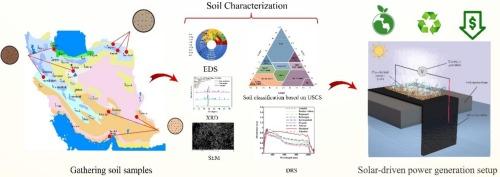太阳能驱动的土壤蒸发发电:一项实验研究
IF 10.9
1区 工程技术
Q1 ENERGY & FUELS
引用次数: 0
摘要
实现可持续能源解决方案的一个有效方法是利用太阳能从自然材料中蒸发引起的水流发电。本研究对太阳能蒸发引起的水流和土壤发电进行了实验研究。首先,对不同分类的土样进行了广泛的实验分析。然后,测量土壤的固有特性,包括光吸收、孔隙度、接触角、渗透率和微孔通道。其中,马什哈德土(按统一土壤分类系统分类为SM粉砂)蒸发效率最高,达到83.4%,开路电压为205毫伏。为了提高光吸收从而增加蒸发速率和电压产生,研究了土壤和活性炭的组合。结果表明,在1 kW·m−2条件下,土壤与活性炭的比例为50/50时,蒸发效率可提高至92%,最大功率密度为0.21 mW·m−2。这些发现表明,土壤-活性炭复合材料可以作为一种简单而有效的方法,用于从太阳辐射和降雨中大规模转换能量。本文章由计算机程序翻译,如有差异,请以英文原文为准。

Solar Driven Evaporation-induced Electricity Generation from Soil: An Experimental Investigation
One effective approach to achieving sustainable energy solutions is the generation of power through solar evaporation-induced water flow from natural materials. This study experimentally investigates electricity generation through solar evaporation-induced water flow and soil. Firstly, a wide range of experimental analyses is conducted on soil samples from various classifications. Then, the intrinsic properties of soil, including light absorption, porosity, contact angle, permeability, and microporous channels, are measured. Among all the samples, Mashhad soil (classified as SM silty sand under the Unified Soil Classification System) showed the best performance, achieving a maximum evaporation efficiency of 83.4 % and an open-circuit voltage of 205 millivolts. To improve light absorption leading to increased evaporation rates and voltage generation, a combination of soil and activated carbon was examined. The results reveal that a 50/50 wt. ratio of soil to activated carbon increases the evaporation efficiency to 92 % and achieves a maximum power density of 0.21 mW·m−2 under 1 kW·m−2 during a closed-circuit test. These findings highlight that a soil–activated carbon composite can serve as a simple yet effective method for large-scale energy conversion from solar radiation and rainfall.
求助全文
通过发布文献求助,成功后即可免费获取论文全文。
去求助
来源期刊

Energy Conversion and Management
工程技术-力学
CiteScore
19.00
自引率
11.50%
发文量
1304
审稿时长
17 days
期刊介绍:
The journal Energy Conversion and Management provides a forum for publishing original contributions and comprehensive technical review articles of interdisciplinary and original research on all important energy topics.
The topics considered include energy generation, utilization, conversion, storage, transmission, conservation, management and sustainability. These topics typically involve various types of energy such as mechanical, thermal, nuclear, chemical, electromagnetic, magnetic and electric. These energy types cover all known energy resources, including renewable resources (e.g., solar, bio, hydro, wind, geothermal and ocean energy), fossil fuels and nuclear resources.
 求助内容:
求助内容: 应助结果提醒方式:
应助结果提醒方式:


